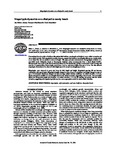Megaripple dynamics on a dissipative sandy beach
Date
2014-02-21Author
Subject
Metadata
Show full item recordAbstract
Conventional force models of bedform dimensions link bedform wavelength and height to wave orbital excursion and wave orbital velocity. Self-organization models, however, suggest that bedform wavelengths either: grow, remain stable, or are wiped flat, but are unable to reduce in length. This paper presents measurements of megaripple evolution on a macrotidal sandy dissipative beach at Perranporth, England, using measurements from a Sand Ripple Profiler. Measurements were made as the tide flooded and ebbed over the instruments, producing a cross-section of the moving surf zone for 12 separate tides. Water depths varied from 1 to 6 m, and wave heights were up to 2.2 m. The data allowed megaripple dimensions to be observed with heights up to 30 cm and wavelengths up to 1.8 m. Megaripples were observed to grow and decay in both length and height. Megaripple spacing did not increase consistently with age of ripple. Megaripple lengths changed at rates of up to 5 cm/minute, and height changed at rates of up to 0.5 cm/minute. Maximum changes took place in large orbital velocity conditions. At orbital velocities > 0.5 m/s, ripples attempted to stabilize at a wavelength related to the orbital excursion, suggesting a forced mode. The most stable ripples had the greatest height and steepness. At orbital velocities < 0.5 m/s the spacing was greater than the orbital excursion, suggesting self-organized growth may be a more appropriate model for small orbital velocities.
Collections
Publisher
Journal
Volume
Issue
Pagination
Recommended, similar items
The following license files are associated with this item:


